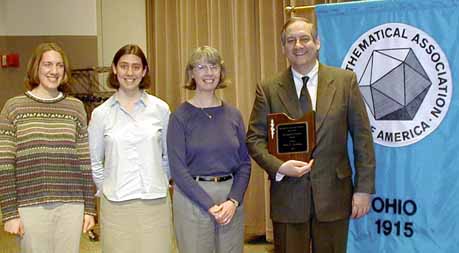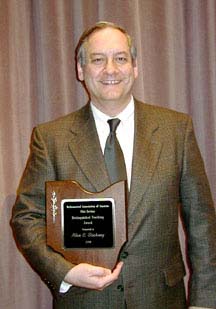
 Professor Alan Stickney of the Department of Mathematics and Computer
Science at Wittenberg University is the tenth recipient of the
prestigious Award for Distinguished College or University Teaching of
Mathematics. The award was presented to Stickney during the recent
spring meeting at Bowling Green.
Professor Alan Stickney of the Department of Mathematics and Computer
Science at Wittenberg University is the tenth recipient of the
prestigious Award for Distinguished College or University Teaching of
Mathematics. The award was presented to Stickney during the recent
spring meeting at Bowling Green.
The Teaching Award is bestowed on faculty members who are widely recognized as successful teachers, have an influence in their teaching of mathematics beyond their own institutions and foster curiosity and excitement about mathematics in their students. Barbara Ashton, Stickney's colleague at Wittenberg, read the citation at the award ceremony noting how well his career fulfills these criteria.
Over the past twenty-five years, Stickney's students have repeatedly cited his patience, encouragement, and clarity of exposition as reasons for their love of mathematics, many becoming professional mathematicians themselves. Stickney himself, when asked to relate an incident he fondly recalls, told of a former student of first year calculus. She had a low "C" grade at midterm. Stickney worked with her in his office three times a week for the rest of the semester. His careful guidance together with her diligence resulted in an A by the end of the semester. She is now a successful high school mathematics teacher. As with many students, she was initially trying to learn the mathematics through rote memorization of facts and techniques rather than by learning the underlying concepts and ideas of the course. By asking her for explanations in his office, Stickney was able to shift her focus away from "How do I do this problem?" to "Why do I do this problem this way?" and she began to do much better in the course.
Stickney's professional home since 1979 has been Wittenberg University where he has risen in the ranks to full professor, chaired his department, and initiated and led a student chapter of the MAA. Ashton noted, "Under his gentle persuasion, his undergraduate students have organized outreach contests with high school students, sponsored department colloquia, participated in the Putnam competition, and presented papers at the Ohio Section meetings"
Stickney earned his bachelor's degree in mathematics from Michigan State University and his master's degree and Ph. D. at the University of Michigan achieving outstanding awards including Phi Beta Kappa and membership in the honorary Sigma Xi.
Over 20 publications have his authorship, most relating to the use of technology in the teaching of college level mathematics. His knowledge and enthusiasm for his teaching and the use of computers and graphing calculators within that teaching has been shared in over 35 talks and workshops and 10 minicourses throughout the state and country. He wrote the original box-zoom program for the Casio graphing calculator and box-zoom is a standard feature of graphing calculators today.
The Stickney family including his wife Ellen and his two daughters Laura and Carolyn were present to see Al receive his award as were a number of enthusiastic Wittenberg students and colleagues. (See below.)
[Delene Perley, PIO]

The family: daughter, Laura, daughter Carolyn, wife Ellen, and Al Stickney.

The Wittenberg group:
Front row, left to right: Curtis Mears, Jessica Meyer, Elizabeth Hardesty
back row, left to right: Brian Shelburne, Alan Stickney, Barbara Ashton,
Jim Noyes, Stalo Monti-Pouagare.
Shelburn, Ashton and Noyes are colleagues of Stickney's at Wittenberg. The
others are Wittenberg mathematics students.